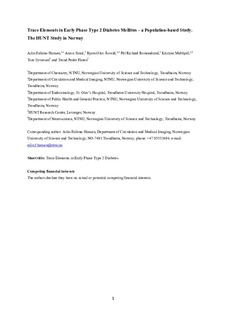Trace Elements in Early Phase Type 2 Diabetes Mellitus – a Population-based Study. The HUNT Study in Norway
| dc.contributor.author | Hansen, Ailin Falkmo | |
| dc.contributor.author | Simic, Anica | |
| dc.contributor.author | Åsvold, Bjørn Olav | |
| dc.contributor.author | Romundstad, Pål Richard | |
| dc.contributor.author | Midthjell, Kristian | |
| dc.contributor.author | Syversen, Tore | |
| dc.contributor.author | Flaten, Trond Peder | |
| dc.date.accessioned | 2017-11-06T08:22:54Z | |
| dc.date.available | 2017-11-06T08:22:54Z | |
| dc.date.created | 2017-01-02T22:07:27Z | |
| dc.date.issued | 2017 | |
| dc.identifier.citation | Journal of Trace Elements in Medicine and Biology. 2017, 40 46-53. | nb_NO |
| dc.identifier.issn | 0946-672X | |
| dc.identifier.uri | http://hdl.handle.net/11250/2464112 | |
| dc.description.abstract | Differences in trace elements levels between individuals with type 2 diabetes and controls have been reported in several studies in various body fluids and tissues, but results have been inconsistent. In order to examine trace element levels in the early phase of type 2 diabetes, we investigated the association between whole blood levels of 26 trace elements and the prevalence of previously undiagnosed, screening-detected type 2 diabetes. The study was conducted as a case-control study nested within the third survey of the population-based Nord-Trøndelag Health Study (HUNT3 Survey). Among participants without previously known diabetes, 128 cases of type 2 diabetes were diagnosed in people with a high diabetes risk score (FINDRISC ≥ 15), and frequency-matched for age and sex with 755 controls. Blood samples were analyzed by high resolution inductively coupled plasma mass spectrometry. Associations between trace element levels and the prevalence of previously undiagnosed type 2 diabetes were evaluated with multivariable conditional logistic regression controlling for age, sex, body mass index, waist-to-hip ratio, education, income, smoking and family history of diabetes. The prevalence of previously undiagnosed type 2 diabetes increased across tertiles/quartiles for cadmium, chromium, iron, nickel, silver and zinc, and decreased with increasing quartiles of bromine (Ptrend < 0.05). After corrections for multiple testing, associations for chromium remained significant (Qtrend < 0.05), while associations for iron and silver were borderline significant. No associations were found for arsenic, boron, calcium, cesium, copper, gallium, gold, indium, lead, magnesium, manganese, mercury, molybdenum, rubidium, selenium, strontium, tantalum, thallium and tin. Our results suggest a possible role of bromine, cadmium, chromium, iron, nickel, silver and zinc in the development of type 2 diabetes. | nb_NO |
| dc.language.iso | eng | nb_NO |
| dc.publisher | Elsevier | nb_NO |
| dc.rights | Attribution-NonCommercial-NoDerivatives 4.0 Internasjonal | * |
| dc.rights.uri | http://creativecommons.org/licenses/by-nc-nd/4.0/deed.no | * |
| dc.title | Trace Elements in Early Phase Type 2 Diabetes Mellitus – a Population-based Study. The HUNT Study in Norway | nb_NO |
| dc.type | Journal article | nb_NO |
| dc.type | Peer reviewed | nb_NO |
| dc.description.version | acceptedVersion | nb_NO |
| dc.source.pagenumber | 46-53 | nb_NO |
| dc.source.volume | 40 | nb_NO |
| dc.source.journal | Journal of Trace Elements in Medicine and Biology | nb_NO |
| dc.identifier.doi | 10.1016/j.jtemb.2016.12.008 | |
| dc.identifier.cristin | 1419557 | |
| dc.description.localcode | © 2016. This is the authors’ accepted and refereed manuscript to the article. LOCKED until 21.12.2017 due to copyright restrictions. This manuscript version is made available under the CC-BY-NC-ND 4.0 license http://creativecommons.org/licenses/by-nc-nd/4.0/ | nb_NO |
| cristin.unitcode | 194,65,25,0 | |
| cristin.unitcode | 194,66,25,0 | |
| cristin.unitcode | 194,65,20,15 | |
| cristin.unitcode | 194,65,20,0 | |
| cristin.unitcode | 194,65,30,0 | |
| cristin.unitname | Institutt for sirkulasjon og bildediagnostikk | |
| cristin.unitname | Institutt for kjemi | |
| cristin.unitname | Helseundersøkelsen i Nord-Trøndelag | |
| cristin.unitname | Institutt for samfunnsmedisin og sykepleie | |
| cristin.unitname | Institutt for nevromedisin og bevegelsesvitenskap | |
| cristin.ispublished | true | |
| cristin.fulltext | postprint | |
| cristin.qualitycode | 1 |

